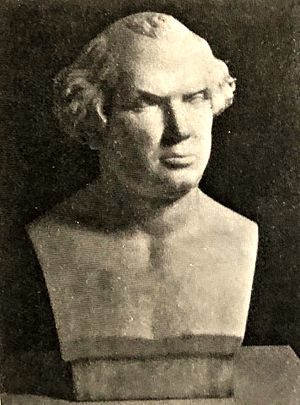Eugene Warburg facts for kids
Quick facts for kids
Eugene Warburg
|
|
|---|---|

Marble bust by Eugene Warburg, 1853
|
|
| Born |
Joseph Eugene Warburg
c. 1825 |
| Died | January 12, 1859 |
| Nationality | American |
| Known for | Portrait sculpture, religious statuary, bas-relief |
Eugene Warburg (1825—1859) was an African-American sculptor. He was born in New Orleans in the mid-1820s. At birth, he was enslaved. His father, who also owned him, gave him his freedom when he was four years old.
Warburg first learned to cut marble. Later, he became a sculptor. He worked in New Orleans during the 1840s and early 1850s. In 1853, he moved to Europe. He became a very successful sculptor there. He continued his work until he passed away in 1859.
Contents
Early Life of Eugene Warburg
Joseph Eugene Warburg was born in New Orleans, Louisiana. This was either in late 1825 or early 1826. His father, Daniel Warburg, was a Jewish immigrant. His family was well-known in Hamburg, Germany.
Eugene's mother was Marie Rose Blondeau. She was an enslaved woman of mixed race. She came from Santiago, Cuba. Marie Rose's mother was also enslaved by Daniel Warburg. Marie Rose was given her freedom after Eugene was born. Eugene was the oldest of his parents' five children. His father gave him his freedom when he was four years old. Marie Rose died in 1837 when she was 33. She left three enslaved people to her five children.
Warburg's Artistic Career
Eugene Warburg learned to cut marble as a young man. He was an apprentice to a French artist named Phillippe Garbeille. When he was in his early twenties, Warburg opened his own art studio. It was located in the French Quarter of New Orleans.
Sculpting in New Orleans
In the 1840s and early 1850s, Warburg created many artworks. He made portrait busts, which are sculptures of a person's head and shoulders. He also made religious statues and gravestones. A notable project was designing the floors for St. Louis Cathedral. This is the oldest cathedral in North America. Warburg was a Catholic his whole life.
In 1850, Warburg showed a special artwork. It was a bas-relief called Ganymede Offering a Cup of Nectar to Jupiter. A bas-relief is a type of sculpture where the figures stick out slightly from a flat background. This piece was shown in New Orleans and cost $500. A local newspaper, The New Orleans Bee, praised his work. They called it an "exquisite specimen of sculpture." The critic said the work "reflects infinite credit upon the taste and talent of our townsmen."
Moving to Europe
Life became harder for Warburg in New Orleans. There were growing tensions, possibly due to jealousy from other artists. This led Warburg to decide to move to Paris. Before leaving, Warburg settled some family matters. He worked with his father to get his share of his mother's estate. His father held a meeting with a notary public and six free men of color. They spoke for Warburg's younger brothers and sisters. Everyone agreed to sell the three enslaved people left to the children. Warburg's share of the estate was worth $252.00. Warburg chose his father to handle his interests. He then sailed for Europe in November 1852.
Success in Europe
From 1852 to 1856, Warburg studied and worked in Paris. Important Americans helped him by writing letters of introduction. These letters helped him meet people who might support his art. One person was John Young Mason, the United States Ambassador to France.
In 1856, Warburg traveled to Belgium and England. He received support from important American and British abolitionists. These were people who wanted to end slavery. They included Harriet Beecher Stowe and Elizabeth Leveson-Gower, Duchess of Sutherland. In 1856, the Duchess of Sutherland asked Warburg to create a series of bas-reliefs. These sculptures were based on the story of Uncle Tom's Cabin.
In 1857, Warburg moved to Italy. He had letters of introduction from Harriet Beecher Stowe and the Duchess of Sutherland. He finally settled in Rome with his wife, Louise Ernestine. Warburg worked successfully as a sculptor in Rome for two years. Sadly, his life ended early. He became ill and died a few days later, on January 12, 1859.
See also

